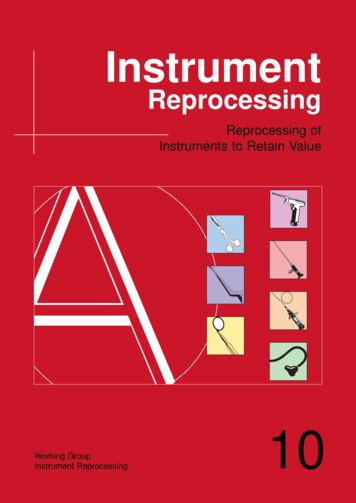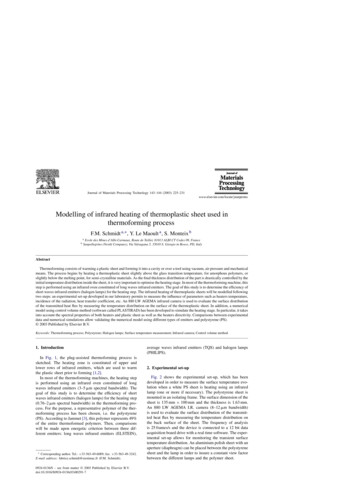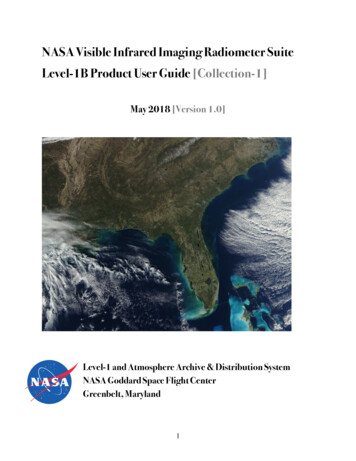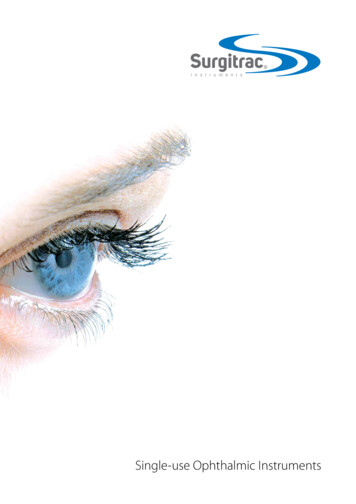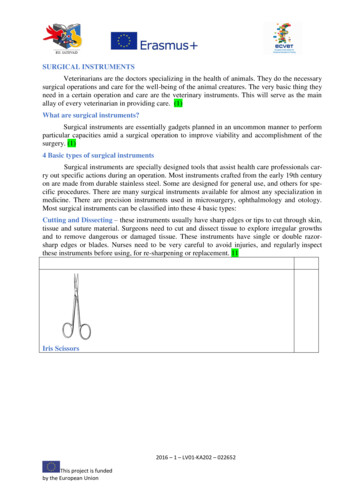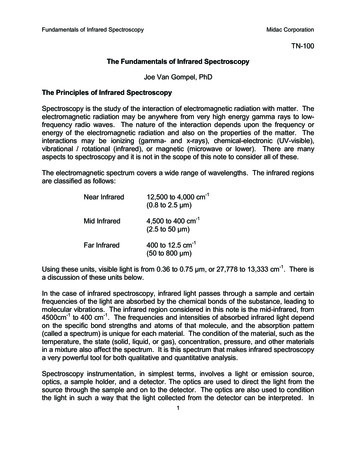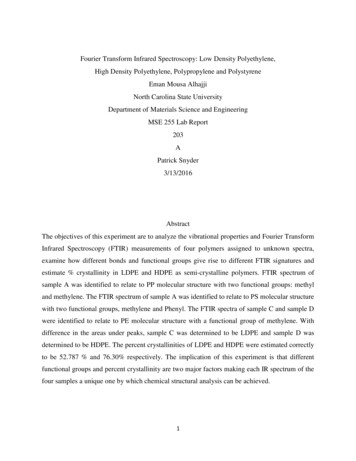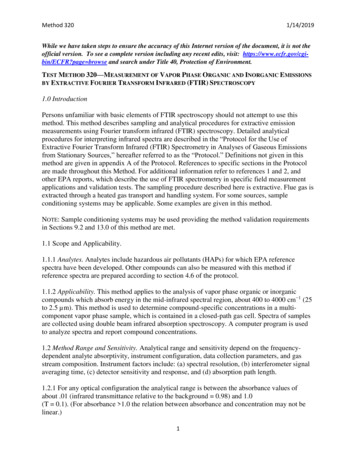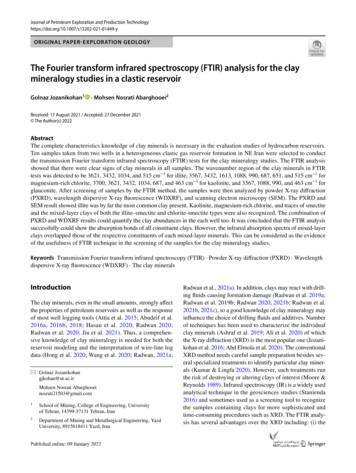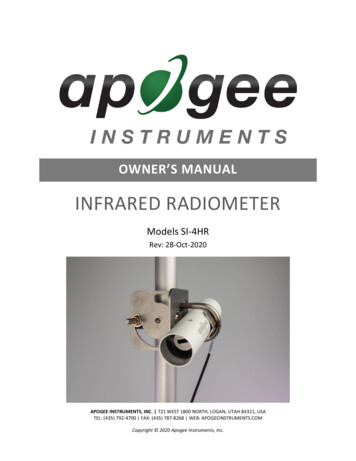
Transcription
OWNER’S MANUALINFRARED RADIOMETERModels SI-4HRRev: 28-Oct-2020APOGEE INSTRUMENTS, INC. 721 WEST 1800 NORTH, LOGAN, UTAH 84321, USATEL: (435) 792-4700 FAX: (435) 787-8268 WEB: APOGEEINSTRUMENTS.COMCopyright 2020 Apogee Instruments, Inc.
TABLE OF CONTENTSOwner’s Manual . 1Declaration of Conformity . 3Introduction . 4Sensor Models . 5Specifications . 6Deployment and Installation . 7Cable Connectors . 9Operation and Measurement . 10Maintenance and Recalibration . 18Troubleshooting and Customer Support . 19Return and Warranty Policy . 20
DECLARATION OF CONFORMITYEU Declaration of ConformityThis declaration of conformity is issued under the sole responsibility of the manufacturer:Apogee Instruments, Inc.721 W 1800 NLogan, Utah 84321USAfor the following product(s):Models: SI-4HRType: Infrared RadiometerThe object of the declaration described above is in conformity with the relevant Union harmonization magnetic Compatibility (EMC) DirectiveRestriction of Hazardous Substances (RoHS 2) DirectiveAmending Annex II to Directive 2011/65/EU (RoHS 3)Standards referenced during compliance assessment:EN 61326-1:2013 Electrical equipment for measurement, control and laboratory use – EMC requirementsEN 50581:2012 Technical documentation for the assessment of electrical and electronic products with respect tothe restriction of hazardous substancesPlease be advised that based on the information available to us from our raw material suppliers, the productsmanufactured by us do not contain, as intentional additives, any of the restricted materials including lead (seenote below), mercury, cadmium, hexavalent chromium, polybrominated biphenyls (PBB), polybrominateddiphenyls (PBDE), bis(2-ethylhexyl) phthalate (DEHP), butyl benzyl phthalate (BBP), dibutyl phthalate (DBP), anddiisobutyl phthalate (DIBP). However, please note that articles containing greater than 0.1% lead concentration areRoHS 3 compliant using exemption 6c.Further note that Apogee Instruments does not specifically run any analysis on our raw materials or end productsfor the presence of these substances, but rely on the information provided to us by our material suppliers.Signed for and on behalf of:Apogee Instruments, October 2020Bruce BugbeePresidentApogee Instruments, Inc.
INTRODUCTIONAll objects with a temperature above absolute zero emit electromagnetic radiation. The wavelengths and intensityof radiation emitted are related to the temperature of the object. Terrestrial surfaces (e.g., soil, plant canopies,water, snow) emit radiation in the mid infrared portion of the electromagnetic spectrum (approximately 4-50 µm).Infrared radiometers are sensors that measure infrared radiation, which is used to determine surface temperaturewithout touching the surface (when using sensors that must be in contact with the surface, it can be difficult tomaintain thermal equilibrium without altering surface temperature). Infrared radiometers are often called infraredthermometers because temperature is the desired quantity, even though the sensors detect radiation.Typical applications of infrared radiometers include plant canopy temperature measurement for use in plant waterstatus estimation, road surface temperature measurement for determination of icing conditions, and terrestrialsurface (soil, vegetation, water, snow) temperature measurement in energy balance studies.Apogee Instruments SI series infrared radiometers consist of a thermopile detector, germanium filter, precisionthermistor (for detector reference temperature measurement), and signal processing circuitry mounted in ananodized aluminum housing, and a cable to connect the sensor to a measurement device. All radiometers alsocome with a radiation shield designed to minimize absorbed solar radiation, but still allowing natural ventilation.The radiation shield insulates the radiometer from rapid temperature changes and keeps the temperature of theradiometer closer to the target temperature. Sensors are potted solid with no internal air space and are designedfor continuous temperature measurement of terrestrial surfaces in indoor and outdoor environments. SI-400series sensors output a digital signal using SDI-12 protocol version 1.3.The SI-4HR-SS infrared radiometer is developed for road weather networks specifically, with a 10 vertical field ofview, allowing for remote detection of a narrow and distant target roadway. The rectangular-shaped aperturemaximizes the horizontal field of view allowing for a larger integrated measurement without including undesiredtarget areas such as sky or surrounding terrain.
SENSOR MODELSModelOutputSI-400 SeriesSDI-12SI-100 SeriesVoltageSensor model number and serial number arelocated on a label near the pigtail leads on thesensor cable. If the manufacturing date of aspecific sensor is required, please contact ApogeeInstruments with the serial number of the sensor.The FOV is shown below:
SPECIFICATIONSInput Voltage RequirementCurrent DrainSI-4HR-SS5.5 to 24 V DC1.5 mA (quiescent), 2.0 mA (active)Calibration Uncertainty (-30 to 65 C), when target anddetector temperature are within 20 C0.3 CCalibration Uncertainty (-40 to 80 C), when target anddetector temperate are different by more than 20 C(see Calibration Traceability below)0.5 CMeasurement RepeatabilityStability (Long-term Drift)Response TimeField of ViewSpectral RangeOperating EnvironmentDimensionsMassCableLess than 0.05 CLess than 2 % change in slope per year when germanium filter ismaintained in a clean condition (see Maintenance and Recalibrationsection below)0.6 s, time for detector signal to reach 95 % following a step change;fastest data transmission rate for SDI-12 circuitry is 1 s5 vertical half angle; 16 horizontal half angle8 to 14 µm; atmospheric window (see Spectral Response below)-50 to 80 C; 0 to 100 % relative humidity (non-condensing)23 mm diameter; 76 mm length219 g (with 5m of lead wire)5 m of two conductor, shielded, twisted-pair wire; TPR jacket (highwater resistance, high UV stability, flexibility in cold conditions);pigtail lead wires; stainless steel (316), M8 connector located 25 cmfrom sensor headCalibration TraceabilityApogee SI series infrared radiometers are calibrated to the temperature of a custom blackbody cone held atmultiple fixed temperatures over a range of radiometer (detector/sensor body) temperatures. The temperature ofthe blackbody cone is measured with replicate precision thermistors thermally bonded to the cone surface. Theprecision thermistors are calibrated for absolute temperature measurement against a platinum resistancethermometer (PRT) in a constant temperature bath. The PRT calibration is directly traceable to the NIST.Spectral ResponseSpectral response of SI series infraredradiometers. Spectral response (green line) isdetermined by the germanium filter andcorresponds closely to the atmospheric windowof 8-14 µm, minimizing interference fromatmospheric absorption/emission bands (blueline) below 8 µm and above 14 µm. Typicalterrestrial surfaces have temperatures that yieldmaximum radiation emission within theatmospheric window, as shown by the blackbodycurve for a radiator at 28 C (red line).
DEPLOYMENT AND INSTALLATIONThe mounting geometry (distance from target surface, angle of orientation relative to target surface) isdetermined by the desired area of surface to be measured. The field of view extends unbroken from the sensor tothe target surface. Sensors must be carefully mounted in order to view the desired target and avoid includingunwanted surfaces/objects in the field of view, thereby averaging unwanted temperatures with the targettemperature (see Field of View below). Once mounted, the green cap must be removed. The green cap can beused as a protective covering for the sensor, when it is not in use.An Apogee Instruments model AM-220 mounting bracket is recommended for mounting the sensor to a cross armor pole. The AM-220 allows adjustment of the angle of the sensor with respect to the target and accommodatesthe radiation shield designed for all SI series infrared radiometers.
Field of ViewThe field of view (FOV) is reported as the half-angle of the apex of the cone formed by the target surface (conebase) and the detector (cone apex), as shown below, where the target is defined as a circle from which 98 % of theradiation detected by the radiometer is emitted.Sensor FOV, distance to target, and sensor mounting angle in relation to the target will determine target area.Different mounting geometries (distance and angle combinations) produce different target shapes and areas, asshown below.CIRCULARHORIZONTALHalf AngleFOV Area (m²)TypeStandardNarrowModelSI-111SI-121Half Angle22 18 0 Deg2.0691.33745 Deg7.6274.46160 Deg45.21118.865Ultra-NarrowSI-13114 Horizontal32 16 Vertical13 5 FOV Area (m²)0 Deg2.2760.40345 Deg7.1481.15-A simple FOV calculator for determining target dimensions based on infrared radiometer model, mounting height,and mounting angle, is available on the Apogee website: 60 Deg45.5123.341
CABLE CONNECTORSApogee offers in-line cable connectors on some barelead sensors to simplify the process of removingsensors from weather stations for calibration (theentire cable does not have to be removed from thestation and shipped with the sensor).The ruggedized M8 connectors are rated IP68, madeof corrosion-resistant marine-grade stainless-steel,and designed for extended use in harshenvironmental conditions.Inline cable connectors are installed 30 cm from thehead(pyranometer pictured)InstructionsPins and Wiring Colors: All Apogee connectorshave six pins, but not all pins are used for everysensor. There may also be unused wire colorsinside the cable. To simplify datalogger connection,we remove the unused pigtail lead colors at thedatalogger end of the cable.If a replacement cable is required, please contactApogee directly to ensure ordering the properpigtail configuration.Alignment: When reconnecting a sensor, arrowson the connector jacket and an aligning notchensure proper orientation.Disconnection for extended periods: Whendisconnecting the sensor for an extended period oftime from a station, protect the remaining half ofthe connector still on the station from water anddirt with electrical tape or other method.Tightening: Connectors are designed to be firmlyfinger-tightened only. There is an O-ring inside theconnector that can be overly compressed if awrench is used. Pay attention to thread alignmentto avoid cross-threading. When fully tightened, 1-2threads may still be visible.A reference notch inside the connector ensuresproper alignment before tightening.When sending sensors in for calibration, only send theshort end of the cable and half the connector.Finger-tighten firmly
OPERATION AND MEASUREMENTAll SI-400 series radiometers have an SDI-12 output, where target and detector temperatures are returned indigital format. Measurement of SI-400 series radiometers requires a measurement device with SDI-12 functionalitythat includes the M or C command.Wiring for SI-4HR-SSWhite: SDI-12 Data LineRed: Power In (4.5-24 V DC)Black: Ground (for sensor signal and input power)Clear: Shield/Ground
Sensor CalibrationApogee SI series infrared radiometers are calibrated in a temperature controlled chamber that houses a custombuilt blackbody cone (target) for the radiation source. During calibration, infrared radiometers (detectors) are heldin a fixture at the opening of the blackbody cone, but are thermally insulated from the cone. Detector and targettemperature are controlled independently. At each calibration set point, detectors are held at a constanttemperature while the blackbody cone is controlled at temperatures below (12 C), above (18 C), and equal to thedetector temperature. The range of detector temperatures is -15 C to 45 C (set points at 10 C increments). Dataare collected at each detector temperature set point, after detectors and target reach constant temperatures.All Apogee SDI-12 infrared radiometer models (SI-400 series) have sensor-specific calibration coefficientsdetermined during the custom calibration process. Coefficients are programmed into the microcontroller at thefactory. Calibration data for each sensor are provided on a calibration certificate (example shown on followingpage).Calibration overview data are listed in box in upper left-hand corner, temperature errors are shown in graph, andcalibration date is listed below descriptions of calibration procedure and traceability.
SDI-12 InterfaceThe following is a brief explanation of the serial digital interface SDI-12 protocol instructions used in Apogee SI-400series infrared radiometers. For questions on the implementation of this protocol, please refer to the officialversion of the SDI-12 protocol: http://www.sdi-12.org/specification.php (version 1.4, August 10, 2016).OverviewDuring normal communication, the data recorder sends a packet of data to the sensor that consists of an addressand a command. Then, the sensor sends a response. In the following descriptions, SDI-12 commands andresponses are enclosed in quotes. The SDI-12 address and the command/response terminators are defined asfollows:Sensors come from the factory with the address of “0” for use in single sensor systems. Addresses “1 to 9” and“A to Z”, or “a to z”, can be used for additional sensors connected to the same SDI-12 bus.“!” is the last character of a command instruction. In order to be compliant with SDI-12 protocol, all commandsmust be terminated with a “!”. SDI-12 language supports a variety of commands. Supported commands for theApogee Instruments SI-400 series infrared radiometers are listed in the following table (“a” is the sensor address.The following ASCII Characters are valid addresses: “0-9” or “A-Z”).Supported Commands for Apogee Instruments SI-400 Series Infrared RadiometersInstruction NameSend Identification CommandMeasurement CommandMeasurement Command w/ CheckCharacterChange Address CommandInstruction SyntaxaI!aM!aMC!aAb!Concurrent Measurement CommandaC!Concurrent Measurement Command w/Check CharacteraCC!Address Query CommandGet Data CommandRunning Average Command?!aD0!aXAVG!DescriptionSend Identification InformationTells the Sensor to take a MeasurementTells the Sensor to take a Measurement and return itwith a Check CharacterChanges the Address of the Sensor from a to bUsed to take a measurement when more than onesensor is used on the same data lineUsed to take a measurement when more than onesensor is used on the same data line. Data is returnedwith a check character.Used when the address is unknown to have the sensoridentify its addressRetrieves the data from a sensorReturns or sets the running average for sensormeasurements.Make Measurement Command: M!The make measurement command signals a measurement sequence to be performed. Data values generated inresponse to this command are stored in the sensor's buffer for subsequent collection using “D” commands. Datawill be retained in sensor storage until another “M”, “C”, or “V” command is executed. M commands are shown inthe following examples:CommandaM! or aM0!aM1!aM2!Responsea0011 cr lf a0012 cr lf a0012 cr If Response to 0D0!Target temperatureTarget temperature and sensor body temperatureTarget millivolts and sensor body temperature
aM3!a0012 cr If aMC! or aMC0!aMC1!aMC2!aMC3!a0011 cr lf a0012 cr lf a0012 cr If a0012 cr If Returns angle offset from vertical in degrees. (0 degrees if pointed up, 180degrees if pointed down.)Target temperature w/ CRCTarget temperature and sensor body temperature w/ CRCTarget millivolts and sensor body temperature w/CRCReturns angle offset from vertical in degrees w/CRC. (0 degrees if pointedup, 180 degrees if pointed down.)where a is the sensor address (“0-9”, “A-Z”, “a-z”) and M is an upper-case ASCII character.The target temperature and sensor body temperature are separated by the sign “ ” or “-“, as in the followingexample (0 is the sor Response00011 cr lf 0 23.4563 cr lf 00012 cr lf 0 23.4563 35.1236 cr lf 00012 cr If 0 1.0 35.1236 cr If 00012 cr If 0 90.2 cr lf Sensor Response when data is ready0 cr lf 0 cr lf 0 cr If 0 cr If where 23.4563 is target temperature, 1.0 is target millivolts, and 35.1236 is detector (sensor body) temperature.Concurrent Measurement Command: aC!A concurrent measurement is one which occurs while other SDI-12 sensors on the bus are also makingmeasurements. This command is similar to the “aM!” command, however, the nn field has an extra digit and thesensor does not issue a service request when it has completed the measurement. Communicating with othersensors will NOT abort a concurrent measurement. Data values generated in response to this command are storedin the sensor's buffer for subsequent collection using “D” commands. The data will be retained in the sensor untilanother “M”, “C”, or “V” command is executed:CommandaC!aC1!aC2!aC3!Responsea00101 cr lf a00102 cr lf a00102 cr If a00102 cr If aCC!aCC1!aCC2!aCC3!a00101 cr lf a00102 cr lf a00102 cr If a00102 cr If Response to 0D0!Target temperatureTarget temperature and sensor body temperatureTarget millivolts and sensor body temperatureReturns angle offset from vertical in degrees. (0 degrees if pointed up, 180degrees if pointed down.)Target temperature w/ CRCTarget temperature and sensor body temperature w/ CRCTarget millivolts and sensor body temperature w/CRCReturns angle offset from vertical in degrees w/CRC. (0 degrees if pointed up,180 degrees if pointed down.)where a is the sensor address (“0-9”, “A-Z”, “a-z”, “*”, “?”) and C is an upper-case ASCII character.For example (0 is the address):Command0C!0D0!0C1!Sensor Response000101 cr lf 0 23.4563 cr lf 000102 cr lf
0D0!0C2!0D0!0C3!0D0!0 23.4563 35.1236 cr lf 000102 cr If 0 1.0 35.1236 cr If 000102 cr If 0 90.2 cr lf where 23.4563 is target temperature, 1.0 is target millivolts, and 35.1236 is detector (sensor body) temperature.Change Sensor Address: aAb!The change sensor address command allows the sensor address to be changed. If multiple SDI-12 devices are onthe same bus, each device will require a unique SDI-12 address. For example, two SDI-12 sensors with the factoryaddress of 0 requires changing the address on one of the sensors to a non-zero value in order for both sensors tocommunicate properly on the same channel:CommandaAb!Responseb cr lf DescriptionChange the address of the sensorwhere a is the current (old) sensor address (“0-9”, “A-Z”), A is an upper-case ASCII character denoting theinstruction for changing the address, b is the new sensor address to be programmed (“0-9”, “A-Z”), and ! is thestandard character to execute the command. If the address change is successful, the datalogger will respond withthe new address and a cr lf .Send Identification Command: aI!The send identification command responds with sensor vendor, model, and version data. Anymeasurement data in the sensor's buffer is not disturbed:Command"aI!"Responsea13Apogee SI-4mmvvvxx xx cr lf DescriptionThe sensor serial number and other identifying values arereturnedwhere a is the sensor address (“0-9”, “A-Z”, “a-z”, “*”, “?”), mm is a the sensor model number (11, 21, 31, or H1),vvv is a three character field specifying the sensor version number, and xx.xx is serial number.Running Average CommandThe running average command can be used to set or query the number of measurements that are averagedtogether before returning a value from a M! or MC! command. For example, if a user sends the command“0XAVG10!” to sensor with address 0, that sensor will average 10 measurements before sending the averagedvalue to the logger. To turn off averaging, the user should send the command “aXAVG1” to the sensor. To querythe sensor to see how many measurements are being averaged, send the command “aXAVG!” and the sensor willreturn the number of measurements being averaged (see table below). The default for sensors is to have averagingturned off.Command NameQuery runningAverageSet runningAverageCharacters SentaXAVG!ResponseanaXAVGn!aDescriptiona sensor address, n number of measurements used inaverage calculation. Note: n may be multiple digits.a sensor address, n number of measurements to be used inaverage calculation. Note: n may be any value from 1 to 100.
Metadata CommandsIdentify Measurement CommandsThe Identify Measurement Commands can be used to view the command response without making ameasurement. The command response indicates the time it takes to make the measurement and the number ofdata values that it returns. It works with the Verification Command (aV!), Measurement Commands (aM!, aM1! aM9!, aMC!, aMC1! aMC9!), and Concurrent Measurement Commands (aC!, aC1! aC9! , aCC!, aCC1! aCC9!).The format of the Identify Measurement Command is the address, the capital letter I, the measurement command,and the command terminator (“!”), as follows: address I command !The format of the response is the same as if the sensor is making a measurement. For the Verification Commandand Measurement Commands, the response is atttn CR LF . For the C Command, it is atttnn CR LF . For theHigh Volume Commands, it is atttnnn CR LF . The address is indicated by a, the time in seconds to make themeasurement is indicated by ttt, and the number of measurements is indicated by n, nn, and nnn. The response isterminated with a Carriage Return ( CR ) and Line Feed ( LF ).Identify Measurement Command example:3IMC2!30032 CR LF The Identify Measurement Command for sensor address 3, M2 command, requesting a CRC.The response from sensor address three indicating that the measurement will take three secondsand two data values will be returned.Identify Measurement Parameter CommandsThe Measurement Parameter Commands can be used to retrieve information about each data value that acommand returns. The first value returned is a Standard Hydrometeorological Exchange Format (SHEF) code. SHEFcodes are published by the National Oceanic and Atmospheric Administration (NOAA). The SHEF code manual canbe found at http://www.nws.noaa.gov/oh/hrl/shef/indexshef.htm. The second value is the units of the parameter.Additional fields with more information are optional.The Measurement Parameter Commands work with the Verification Command (aV!), Measurement Commands(aM!, aM1! aM9!, aMC!, aMC1! aMC9!), and Concurrent Measurement Commands (aC!, aC1! aC9! , aCC!,aCC1! aCC9!).The format of the Identify Measurement Parameter Command is the address, the capital letter I, the measurementcommand, the underscore character (“ ”), a three-digit decimal number, and the command terminator (“!”). Thethree-digit decimal indicates which number of measurement that the command returns, starting with “001” andcontinuing to “002” and so on, up to the number of measurements that the command returns. address I command three-digit decimal !The format of the response is comma delimited and terminated with a semicolon. The first value is the address.The second value is the SHEF code. The third value is the units. Other optional values may appear, such as adescription of the data value. The response is terminated with a Carriage Return ( CR ) and Line Feed ( LF ).
a, SHEF Code , units ; CR LF Identify Measurement Parameter Command example:1IC 001!1,RW,Watts/meter squared,incoming solar radiation; CR LF The Identify Measurement ParameterCommand for sensor address 1, Ccommand, data value 1.The response from sensor address 1, SHEFcode RW, units of Watts/meter squared,and additional information of incomingsolar radiation.Target Temperature MeasurementSI-400 series infrared radiometers have an SDI-12 output. The following equations and the custom calibrationcoefficients described in this section are programmed into the microcontroller. Target temperature is outputdirectly in digital format.The detector output from SI series radiometers follows the fundamental physics of the Stefan-Boltzmann Law,where radiation transfer is proportional to the fourth power of absolute temperature. A modified form of theStefan-Boltzmann equation is used to calibrate sensors, and subsequently, calculate target temperature:TT TD m S D b44(1)where TT is target temperature [K], TD is detector temperature [K], SD is the millivolt signal from the detector, m isslope, and b is intercept. The mV signal from the detector is linearly proportional to the energy balance betweenthe target and detector, analogous to energy emission being linearly proportional to the fourth power oftemperature in the Stefan-Boltzmann Law.During the calibration process, m and b are determined at each detector temperature set point (10 C incrementsacross a -15 C to 45 C range) by plotting measurements of TT4 – TD4 versus mV. The derived m and b coefficients arethen plotted as function of TD and second order polynomials are fitted to the results to produce equations thatdetermine m and b at any TD:m C2 TD C1 TD C0(2)b C2 TD C1 TD C0(3)22Where C2, C1, and C0 are the custom calibration coefficients listed on the calibration certificate (shown above)that comes with each SI-100 series radiometer (there are two sets of polynomial coefficients, one set for m andone set for b). Note that TD is converted from Kelvin to Celsius (temperature in C equals temperature in K minus273.15) before m and b are plotted versus TD.To make measurements of target temperatures, Eq. (1) is rearranged to solve for T T [C], measured values of SD andTD are input, and predicted values of m and b are input: TT TD m SD b4 14 273 .15(4)
Emissivity CorrectionAppropriate correction for surface emissivity is required for accurate surface temperature measurements. Thesimple (and commonly made) emissivity correction, dividing measured temperature by surface emissivity, isincorrect because it does not account for reflected infrared radiation.The radiation detected by an infrared radiometer includes two components: 1. radiation directly emitted by thetarget surface, and 2. reflected radiation from the background. The second component is often neglected. Themagnitude of the two components in the total radiation detected by the radiometer is estimated using theemissivity (ε) and reflectivity (1 - ε) of the target surface:ESensor ET arget 1 E Background(1)where ESensor is radiance [W m-2 sr-1] detected by the radiometer, ETarget is radiance [W m-2 sr-1] emitted by thetarget surface, EBackground is radiance [W m-2 sr-1] emitted by the background (when the target surface is outdoorsthe background is generally the sky), and ε is the ratio of non-blackbody radiation emission (actual radiationemission) to blackbody radiation emission at the same temperature (theoretical maximum for radiation emission).Unless the target surface is a blackbody (ε 1; emits and absorbs the theoretical maximum amount of energybased on temperature), Esensor will include a fraction (1 – ε) of reflected radiation from the background.Since temperature, rather than energy, is the desired quantity, Eq. (1) can be written in terms of temperatureusing the Stefan-Boltzmann Law, E σT4 (relates energy being emitted by an object to the fourth power of itsabsolute temperature): TSensor TT arget 1 TBackground444(2)where TSensor [K] is temperature measured by the infrared radiometer (brightness temperature), T Target [K] is actualtemperature of the target surface, TBackground [K] is brightness temperature of the background (usually the sky), andσ is the Stefan-Boltzmann constant (5.67 x 10-8 W m-2 K-4). The power of 4 on the temperatures in Eq. (2) is valid forthe entire blackbody spectrum.Rearrangement of Eq. (2) to solve for TTarget yields the equation used to calculate the actual target surfacetemperature (i.e., measured brightness temperature corrected for emissivity effects):TSensor 1 TBackground4TT arget 44 .(3)Equations (1)-(3) assume an infinite waveband for radiation emission and constant ε at all wavelengths. Theseassumptions are not valid because infrared radiometers do not
Narrow SI-121 18 1.337 4.461 18.865 Narrow SI-4HR 16 5 0.403 1.15 3.341 Ultra-Narrow SI-131 14 0.787 2.447 8.544 - A simple FOV calculator for determining target dimens

